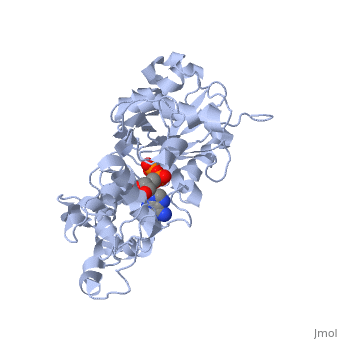2zwh
From Proteopedia
(Difference between revisions)
| Line 1: | Line 1: | ||
| - | + | ==Model for the F-actin structure== | |
| - | === | + | <StructureSection load='2zwh' size='340' side='right' caption='[[2zwh]], [[Resolution|resolution]] 3.30Å' scene=''> |
| - | + | == Structural highlights == | |
| + | <table><tr><td colspan='2'>[[2zwh]] is a 1 chain structure with sequence from [http://en.wikipedia.org/wiki/Oryctolagus_cuniculus Oryctolagus cuniculus]. Full crystallographic information is available from [http://oca.weizmann.ac.il/oca-bin/ocashort?id=2ZWH OCA]. For a <b>guided tour on the structure components</b> use [http://oca.weizmann.ac.il/oca-docs/fgij/fg.htm?mol=2ZWH FirstGlance]. <br> | ||
| + | </td></tr><tr id='ligand'><td class="sblockLbl"><b>[[Ligand|Ligands:]]</b></td><td class="sblockDat"><scene name='pdbligand=ADP:ADENOSINE-5-DIPHOSPHATE'>ADP</scene>, <scene name='pdbligand=CA:CALCIUM+ION'>CA</scene></td></tr> | ||
| + | <tr id='NonStdRes'><td class="sblockLbl"><b>[[Non-Standard_Residue|NonStd Res:]]</b></td><td class="sblockDat"><scene name='pdbligand=HIC:4-METHYL-HISTIDINE'>HIC</scene></td></tr> | ||
| + | <tr id='resources'><td class="sblockLbl"><b>Resources:</b></td><td class="sblockDat"><span class='plainlinks'>[http://oca.weizmann.ac.il/oca-docs/fgij/fg.htm?mol=2zwh FirstGlance], [http://oca.weizmann.ac.il/oca-bin/ocaids?id=2zwh OCA], [http://www.rcsb.org/pdb/explore.do?structureId=2zwh RCSB], [http://www.ebi.ac.uk/pdbsum/2zwh PDBsum]</span></td></tr> | ||
| + | </table> | ||
| + | <div style="background-color:#fffaf0;"> | ||
| + | == Publication Abstract from PubMed == | ||
| + | Actin plays crucial parts in cell motility through a dynamic process driven by polymerization and depolymerization, that is, the globular (G) to fibrous (F) actin transition. Although our knowledge about the actin-based cellular functions and the molecules that regulate the G- to F-actin transition is growing, the structural aspects of the transition remain enigmatic. We created a model of F-actin using X-ray fibre diffraction intensities obtained from well oriented sols of rabbit skeletal muscle F-actin to 3.3 A in the radial direction and 5.6 A along the equator. Here we show that the G- to F-actin conformational transition is a simple relative rotation of the two major domains by about 20 degrees. As a result of the domain rotation, the actin molecule in the filament is flat. The flat form is essential for the formation of stable, helical F-actin. Our F-actin structure model provides the basis for understanding actin polymerization as well as its molecular interactions with actin-binding proteins. | ||
| - | + | The nature of the globular- to fibrous-actin transition.,Oda T, Iwasa M, Aihara T, Maeda Y, Narita A Nature. 2009 Jan 22;457(7228):441-5. PMID:19158791<ref>PMID:19158791</ref> | |
| - | + | ||
| + | From MEDLINE®/PubMed®, a database of the U.S. National Library of Medicine.<br> | ||
| + | </div> | ||
==See Also== | ==See Also== | ||
*[[Actin|Actin]] | *[[Actin|Actin]] | ||
*[[F-actin|F-actin]] | *[[F-actin|F-actin]] | ||
| - | + | == References == | |
| - | == | + | <references/> |
| - | < | + | __TOC__ |
| + | </StructureSection> | ||
[[Category: Oryctolagus cuniculus]] | [[Category: Oryctolagus cuniculus]] | ||
| - | [[Category: Aihara, T | + | [[Category: Aihara, T]] |
| - | [[Category: Iwasa, M | + | [[Category: Iwasa, M]] |
| - | [[Category: Maeda, Y | + | [[Category: Maeda, Y]] |
| - | [[Category: Narita, A | + | [[Category: Narita, A]] |
| - | [[Category: Oda, T | + | [[Category: Oda, T]] |
[[Category: Atp-binding]] | [[Category: Atp-binding]] | ||
[[Category: Contractile protein]] | [[Category: Contractile protein]] | ||
Revision as of 14:02, 17 December 2014
Model for the F-actin structure
| |||||||||||

